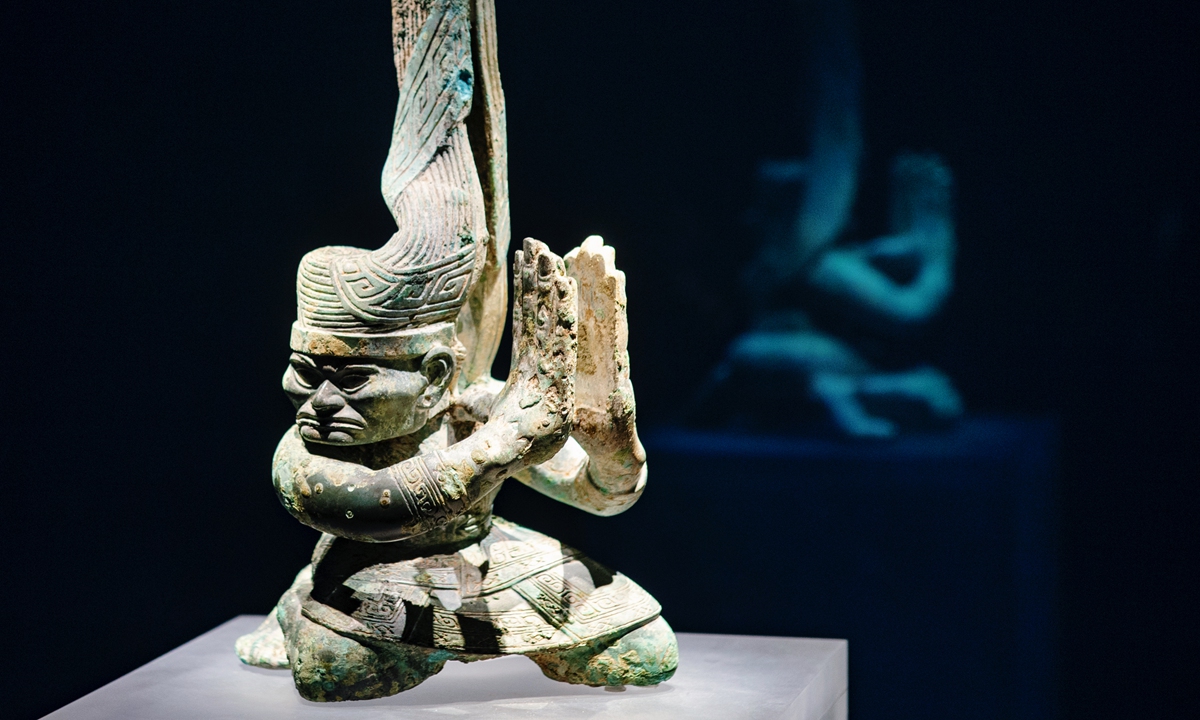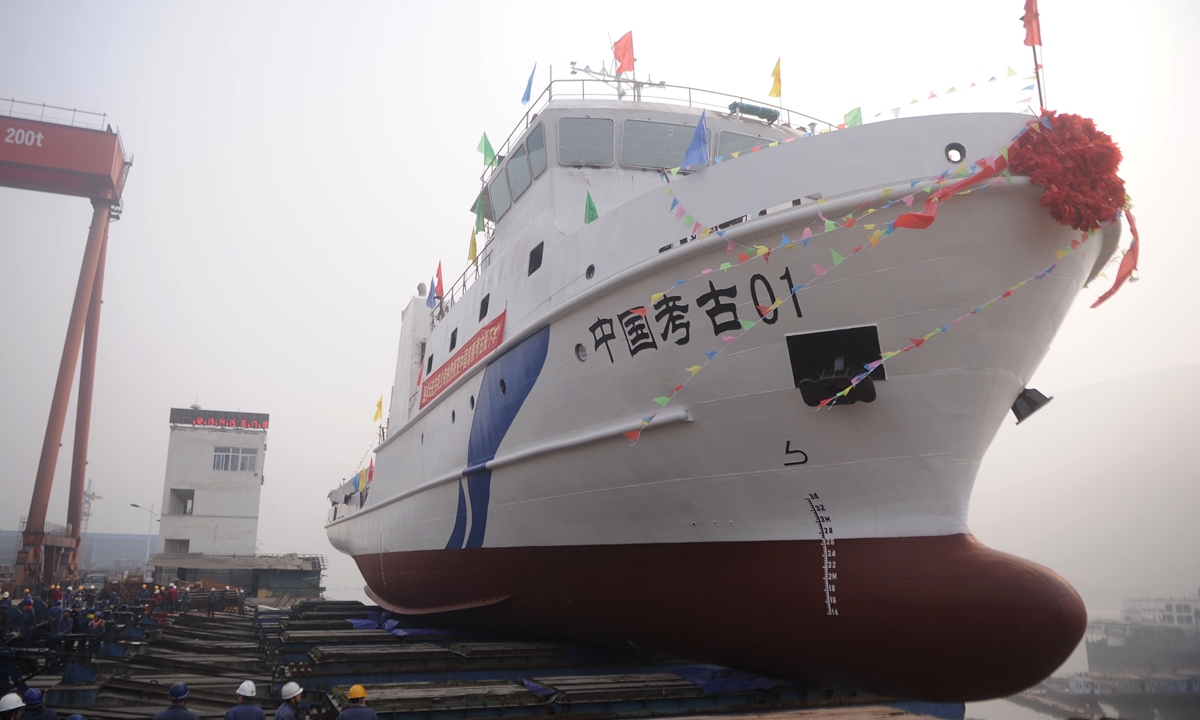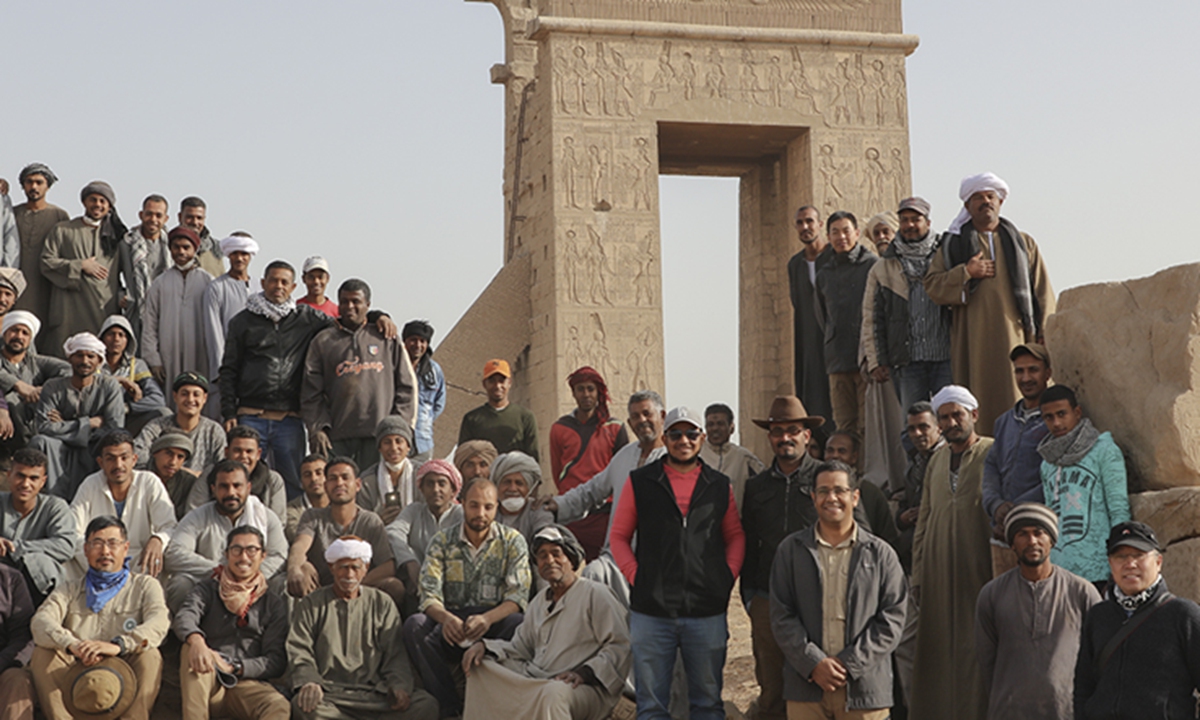Peking University, April 30, 2022: Chinese archaeology, as aided by cutting-edge technology and the passionate efforts of a vibrant new generation of archaeologists, has been in its golden age in the past decade.
A statue in a kneeling position with its head turned is on display at the Sichuan Museum in Chengdu, capital of Southwest China's Sichuan Province, on September 28, 2021. Photo: VCG
Chinese President Xi Jinping has also urged college students studying archaeology to take the study on as a historical responsibility, with an increasing number of young people being encouraged to follow an archaeological path which is far more interesting than initially thought.
On May 2, 2013, President Xi wrote a letter to students of archaeology and museology in Peking University whom he had met at the university in 2012, encouraging them to view archaeological work as a historical responsibility.
Wang Siyu, who was a Peking University student at the time, told the Global Times that it was this letter that strengthened his resolve and made him feel that the major he was studying was not only to satisfy his own interests, but also to complete a mission - to contribute wisdom and energy to the nation's cultural rejuvenation.
Ten years on, Wang has become a scholar at Peking University and gives lectures to the students in the School of Archaeology and Museology.
He said that in the past 10 years, he has deeply felt the vigorous development of Chinese archaeology. "When we were students, archaeology was actually an unpopular subject, but now more young people are applying to this major, which makes me proud."
Shen Ruiwen, dean at the School of Archaeology and Museology of Peking University, told the Global Times that the number of students who take the initiative to apply for archaeology-related majors has increased significantly in the past couple of years, and the great popularity of the major among young people has been boosted by the great attention and support from the Chinese government.
On September 28, 2020, President Xi, while presiding over a group study session of the Political Bureau of the CPC Central Committee, stressed developing archaeology to better understand the long-standing and profound Chinese civilization.
On October 17, 2021, Xi made the remarks calling for developing archaeology with Chinese features, style and ethos in a congratulatory letter on the 100th anniversary of the discovery of the Yangshao Culture and the advent of China's modern archaeology.
Shen said the driving force behind the hard work of generations of archaeologists in the past century has been their love and passion for archaeology, their sense of responsibility, and their growing cultural confidence.
He mentioned that Chinese and Western archaeology are essentially different in research methods: Western archaeology focuses on research from the perspective of anthropology, while Chinese archaeology is more based on reliable historical documents.
China's first archeological expedition ship,?China Kaogu 01, is unveiled in Qingdao, East China's Shandong Province, on January 24, 2014. Photo: cnsphoto
Great achievements of Chinese archaeology
According to Shen, Chinese archaeology has witnessed its "Golden Age" in the past 10 years, and this can be observed in the science and technology supporting archaeological projects, interdisciplinary archaeology, international joint archaeology, the restoration of cultural relics, and the repatriation of cultural relics lost overseas.
In 2020, the world's first mobile 3D-printed 1:1 replica cave of the Yungang Grottoes, the 1,500-year-old masterpiece of Chinese Buddhist art and a UNESCO world heritage site, made its debut in a museum in East China's Zhejiang Province, and was opened to global visitors both on and offline.
In the same year, the bronze horse zodiac head, which had been stolen by British and French troops 160 years ago, returned to its original home, the Old Summer Palace, or Yuanmingyuan, in Beijing, becoming the first significant overseas cultural relic to return to the palace.
In 2021, China boasts 56 UNESCO World Heritage sites, ranking second in the world, after historical sites in Quanzhou were, together, recognized by UNESCO as World Heritage at the 44th session of the World Heritage Committee held in Fuzhou, East China's Fujian Province.
In March, the new discoveries at the famous Sanxingdui Ruins in Southwest China's Sichuan Province, one of the most sought-after archaeological wonders on Chinese social media, was annotated as one of China's top 10 archaeological discoveries of 2021 by China's National Cultural Heritage Administration (NCHA).
As an archaeologist who came to the forefront to witness this major historical discovery, the head of the archaeological team at the Sanxingdui Ruins site, Ran Honglin, told the Global Times that these major archaeological discoveries such as Sanxingdui Ruins can also reflect the rapid development of Chinese archaeology.
He pointed out that the application of scientific archaeological tools and the innovative work concepts, like the simultaneous implementation of multi-disciplinary joint archaeological and cultural relic protection, have greatly improved the efficiency of Sanxingdui archaeological work.
Ran said that in the past 10 years, his work's orientation has also changed. He realized that he is not only an archaeologist, but also a protector of cultural heritage and disseminator of Chinese culture. He expressed his wish to provide a complete archaeological analysis of the Sanxingdui Ruins site to the world and allow the site to be inducted as a UNESCO world heritage one day.
Chinese and Egyptian archaeologists pose for a picture at the Montu Temple site in Luxor, Egypt. Photo: Courtesy of Jia Xiaobing
Entering the world stage
According to Shen, the application of science and technology in archaeology also helps integrate Chinese archaeology into global archaeology. Because global archaeological practices are standardized, any findings can be used as a common starting point to further scientific inquiry. This application also increases the possibility of Chinese scholars to turn international focus onto Chinese archaeology.
Jia Xiaobing, a research fellow at the Chinese Academy of Social Sciences' Institute of Archeology, told the Global Times that he could feel China's increased global influence as we are having more joint international cooperation in archaeology and in the hosting of exhibitions.
Jia once participated in a joint archaeological project between China and Uzbekistan which started in 2012. The work was carried out at the Mingtepa ruins in the southeast of the Fergana Valley in Uzbekistan, and it has provided important materials in the study of the ancient Silk Road and cultural exchanges between the East and the West.
In 2020, Jia led a Chinese archaeology team to Egypt amid the pandemic for a joint archaeological expedition at the Montu Temple site in Luxor, Egypt. That was China's first archaeological mission to Egypt, and the two teams have since conducted deep academic communication in archaeology.
Huo Zhengxin, a law professor at the China University of Political Science and Law, told the Global Times that China has carried out more than 50 archaeological investigations, excavations, and academic research projects in more than 20 countries along the Belt and Road Initiative corridor including Vietnam, Cambodia, Laos, Mongolia, Bangladesh, Pakistan and Iran.
He added that the work in the repatriation of lost Chinese cultural relics from abroad has also made a lot of breakthroughs in the past decade.
According to Huo, China has signed bilateral agreements with 23 countries on the recovery and repatriation of lost cultural relics. These countries not only include countries like Turkey and Peru whose cultural relics were lost, but also the lost cultural relic destination countries such as the US and Australia, which laid a solid foundation for China's recovery of lost cultural relics.
Highly rated by overseas scholars
As one of the greatest discoveries in the field of archaeology in China, the Sanxingdui Ruins site has stunned China as well as the rest of the world.
Professor Rowan Flad, the Archaeology Program Director at Harvard University, called the new findings at the Sanxingdui Ruins in 2021 "a stunning set of discoveries" in an opinion piece in The Washington Post.
"My opinion piece was stimulated by a question asked to me by a journalist who wanted to know why the Egyptian find I discussed [which was a 3,000-year-old 'lost golden city' uncovered in early April 2021, in Luxor, Egypt] had received media coverage while the exciting finds at Sanxingdui had not been highlighted at all in US news media," the renowned archaeologist told the Global Times through an email on Sunday.
In this piece titled "It's a golden age for Chinese archaeology - and the West is ignoring it" in The Washington Post, the archaeologist who has vast experience and has been in collaboration with China's archaeology field, thought highly of the findings at Sanxingdui.
"That discovery, in and of itself doesn't make this a golden age for archaeology in China, but it is reflective of the growth and sophistication of the field in China today," he explained to the Global Times, as he hopes to expose the misconception among many archaeologists who have no personal experience with Chinese archaeology that the discipline is still quite insular and unsophisticated in China.
"Those of us who work in China, however, know that this is far from true." In Rowan's eyes, the Chinese government has invested tremendous resources in developing the capacity of the field for more than two decades especially in the past 10 years. There are leading experts in many archaeological specialties in China due to the active international collaborations; the opening up of the discipline to collaboration with foreign scholars, and the opportunities that Chinese archaeologists have had to go abroad and study and visit have transformed the field. Scholars have returned to China with new abilities and have set up research projects, laboratories, and programs that are on par with the best in the world. The multiple nationally sponsored projects have stimulated collaboration within China among many major institutes and universities.
"I think the scientific sophistication of the work that has been done at Sanxingdui is a great example of this spirit of collaboration and sophistication," he said.
"It is important that this trend continues to involve international engagement. That will ensure that the best new techniques in other regions can continue to be incorporated into Chinese archaeology and equally importantly, that the best work in China can influence archaeological practice in other parts of the world."


